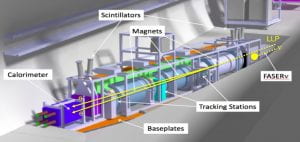FASER Experiment at CERN
Faculty
FASER (ForwArd Search ExpeRiment) is one of eight particle physics experiments at the Large Hadron Collider (LHC) at CERN. It is designed to both search for new light and weakly coupled elementary particles, and to study the interactions of high-energy neutrinos.
In early 2021, crews completed the FASER detector installation in the service tunnel TI12, which is 480 m downstream from the interaction point used by the ATLAS experiment. This location puts it into an intense and highly collimated beam of neutrinos as well as possible new particles. Additionally, it is shielded from ATLAS by about 100 meters of rock and concrete, providing a low background environment. The FASER experiment was approved in 2019 and took its first data in March 2021.
FASER data is reconstructed as it is recorded in an automated workflow that includes extensive monitoring, automated alarms, and automated recovery procedures. The Oregon group worked to develop the FASER monitoring framework, and will operate and maintain the code during Run 3 of the LHC. As the experiment progresses, the Oregon group will work with other FASER collaborators to incorporate more sophisticated analyses into the monitored quantities of the detector. Members of our group have the opportunity to live in the Geneva, Switzerland area and work in the international community of particle physicists at CERN.
This work is supported by the National Science Foundation (award 2110929-PHY), Heising-Simons Foundation, Simons Foundation, and the European Organization for Nuclear Research (CERN).
